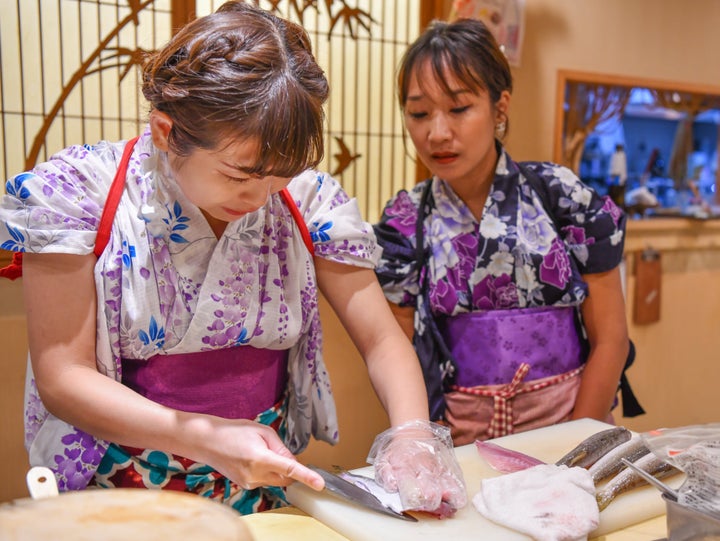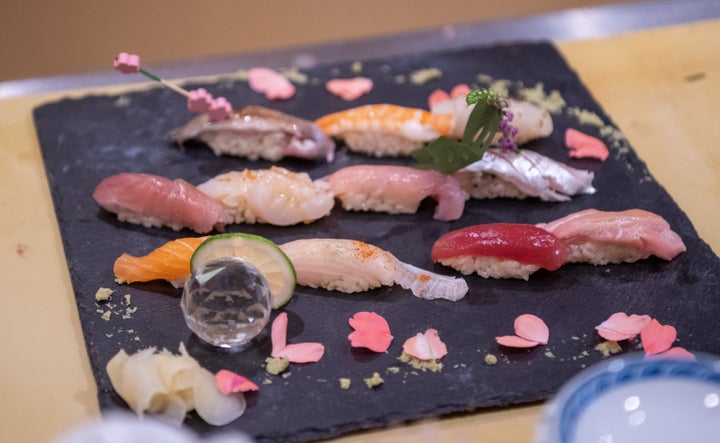
It’s early September in Akihabara, a district of Tokyo bustling with young people and foreign tourists. As night begins to envelop the city, an elegant-looking billboard emblazoned with the words “Nadeshiko Sushi” lights up on a small back street. Patrons are greeted by a chorus of “welcomes” from female staff as they walk through the door on the second floor.
All of Nadeshiko Sushi’s employees are women, including the chefs. It’s a rare occurrence in the world of sushi chefs, where the tendency to discriminate against women is no secret. Prejudicial remarks like “women’s palms are warmer, which spoils the ingredients” and “their time of the month affects the taste” are common.
“When someone I assumed to be a manager or CEO visited with some of his staff, one of them offered to try the sushi first to make sure it was ‘safe to eat,’” said manager and chef Yuki Chizui. “On a separate occasion, one of my staff was told by another male customer to switch with someone else as she was supposedly ‘too fat.’ Things like this happen all the time.”
Instead of donning the traditional white outfit worn by chefs, Chizui and her colleagues opt for colorful kimonos. The chefs adorn their pulled-back hair with jewelry and other accessories and do not shy away from using makeup.
“A sushi chef I used to train with once taught me that ‘sushi preparation is a public affair.’ Crafting sushi with your hands is a performance ― I like to think of chefs as entertainers, and so I dress in a way that reflects that,” Chizui explained.
But some customers criticize their appearance, claiming the chefs’ hair and foundation will fall onto the sushi they’re making.
“Is there makeup in this day and age that actually falls off your face? We use hairspray to keep our hair in place, and besides, hair falling out isn’t something that only happens to women,” Chizui said. Yet there are restaurants, she noted, “where women aren’t even allowed to step foot in the kitchen without shaving their hair into a crew cut.”
The backlash against Nadeshiko Sushi isn’t confined to ordinary customers. The restaurant has also come under attack from others in the industry. One male sushi chef visiting with a woman from a local hostess bar turned to her and said, “I’m not touching this. You eat it.”

When another chef questioned her about the authenticity of her establishment, Chizui said she was quick to defend herself.
“We have pride in what we do,” she countered. “If you really are a sushi chef, doesn’t an accusation like that go directly against your sense of pride? Would you talk like that at one of the famous restaurants?”
‘A Woman For Consumption’
Nadeshiko Sushi has had female chefs behind the counter since it first opened its doors in September 2010. Chizui was there to fulfill a dream.
As a junior art college student, she’d made money working at a sushi restaurant. Later, she had a job at a department store, but the restaurant business called her back.
“I worked part time at a local sushi restaurant in Asakusa for a few years. I only ever worked on the customer side of the counter, as making sushi myself would have been unheard of,” she said. “I was finally allowed to prepare the sweet shrimp after working there for a number of years, which demonstrated to me just how big the barrier for women is.”
In the beginning, Nadeshiko Sushi’s female sushi chefs were not chefs in the true sense of the term. While they assembled the sushi, they followed a set menu decided well in advance. The preparation of ingredients and other culinary responsibilities were still carried out by male chefs.
The management company at the time hoped that the facade of gorgeous female chefs would make the restaurant stand out. And indeed the idea of “moe sushi” (literally, cute sushi) caused a stir, receiving widespread exposure in the media.
But even with all the attention, the restaurant only began pulling in customers about two months after it opened. Meanwhile, tensions developed between the male chefs and the female employees, driving staff away.
“Although I’d finally become the sushi chef I’d dreamed of, the restaurant needed to succeed from a business standpoint. In order to meet the needs of customers, I sometimes wore a maid uniform. It was incredibly frustrating,” Chizui reflected, referring to a costume popular in the “maid cafes” of the Akihabara district.
During that time, a casual interview with an overseas media outlet changed Chizui’s way of thinking.
“In their article, I was reported as ‘Yuki Chizui: The sushi chef cutting away at Japan’s patriarchy.’ Seeing that led me to a stark realization. Something felt out of place being seen simply as a woman for consumption. I had wanted to change the world of sushi chefs but had lost touch with reality somewhere along the way. I’d found myself simply pandering to what society wanted,” she said.
With the restaurant at risk of closing, Chizui handed the then-owner a new plan for the business. It called for women to work as the real sushi chefs.
As manager, Chizui turned to sushi chefs at the restaurant where she used to work for guidance on food preparation and professional conduct. Her mentors introduced her to fish suppliers, and she eventually gained enough knowledge to purchase the ingredients by herself. While some people were not initially interested in dealing with Chizui due to her gender, others were inspired by her enthusiasm. One such supplier was Noji Kiyo at Toyosu Market.

“She’s working hard, facing pressure from an industry dominated by men. She’s very humble, and I want to support her,” manager Yusuke Yamazaki said.
As the restaurant changed, conflict arose with customers, too. Patrons teased and made fun of Chizui for being a female sushi chef. Though she could generally pass off any insults thrown her way, when she stood her ground she was considered “cheeky” or “brash.”
“I fought with customers, too. But this was because I felt like I had to hold strong for the sake of the other female employees and women who were aiming to become sushi chefs,” she said.
Over time, customers began to adjust. “If you think about it, it’s not unusual for women to cook. It’s natural as far as I see it,” said one male customer who’s a regular there. “Many sushi restaurants have chefs that create an almost somber environment, one where customers just sit and eat in silence. Chizui has created a much more comfortable and relaxed setting, one that makes you want to come back.”
Nadeshiko Sushi has started to attract foreigners, too. One woman from Morocco said she was enticed to visit by an advertisement she heard on a tour bus, promising a “sushi restaurant where all the chefs are women.”
“I’d thought sushi chefs were exclusively male, so that certainly piqued my interest. Everyone is really friendly and sociable, and the presentation is beautiful,” she said.
Four years after it opened, the restaurant finally had an entirely female staff. Nowadays, Chizui and her team are developing programs to train more chefs and participating in sushi performances overseas.
Her Striking Designs
As that male customer noted, restaurants overseen by male sushi chefs often have a quiet and solemn atmosphere. Visitors to Nadeshiko Sushi are presented with a gentler environment. The restaurant even has a play area for children, so parents can relax while they enjoy sushi at the counter.
The most striking characteristic of Nadeshiko Sushi is how beautifully the sushi is arranged.

“Sushi comprises two elements: rice and a topping. While the colors and shapes themselves are simple, in terms of design, I feel the two ingredients are incredibly harmonious with one another,” Chizui said. “I studied some cake design as part of my studies at college, and that’s something that I draw on when inventing new ways to arrange and present sushi.”
She changes the fish she uses and the presentation of the food based on the season. She uses a carving knife to carefully craft pictures out of bamboo leaves and incorporates those creations into her presentations.
As Nadeshiko Sushi enters its 10th year of operation, the chef is looking ahead for female sushi chefs.
“The stages in a woman’s life are always changing, whether it be with marriage, childbirth or so on. With these changes, some women have regretfully had to leave their place of work,” said Chizui. “I want to do what I can to support these women. I want to help turn the role of a sushi chef into a lifelong career choice for women, free from discrimination and prejudice.”